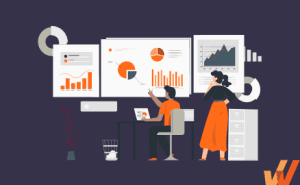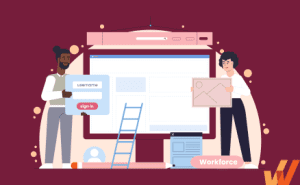What Is People Analytics? Benefits, Examples, Tools (2024)
- Published:
- Modified: April 14, 2022

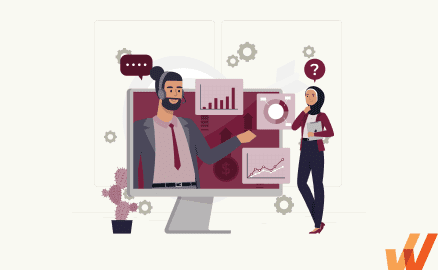
People analytics is at the center of HR transformation. To get to the heart of workforce transformation, people analytics uses statistical insights from employee data to manage talent, drive performance, and enable employees.
A Deloitte and Visier survey of 500 business leaders revealed low confidence in addressing some of their most pervasive, everyday business and people topics. However, with better access to people data, 70% of executives say they could make better people-related decisions, faster.
People analytics empower HR teams and people managers make data-driven decisions to maximize employee potential and business results. This is why organizations that use people analytics well outperform those that don’t.
As we explore the intricacies of people analytics, we uncover not just the power of data in shaping the future of work but also its potential to foster a more efficient workforce. This exploration is not merely about harnessing technology for organizational gain; it’s about redefining the very essence of human resource management to create workplaces that thrive on understanding, inclusivity, and foresight.
What Is People Analytics?
People analytics leverages big data, statistical analysis, and predictive modeling to understand and optimize the workforce. It encompasses gathering, analyzing, and applying data related to employee engagement and performance to make informed decisions that drive organizational effectiveness.
By harnessing the power of people analytics, organizations can uncover deep insights into talent acquisition, retention strategies, productivity enhancement, and leadership development, ultimately leading to more strategic decision-making. This approach not only supports the identification of underlying trends and patterns within the workforce but also enables the creation of more personalized and efficient HR policies and practices, significantly contributing to the overall success of the organization.
Examples of People Analytics in the Workplace
People analytics go far beyond simple employee satisfaction surveys. There are an endless number of use cases that people analytics is applicable (and helpful) to.
These are a few of the best use cases for people analytics:
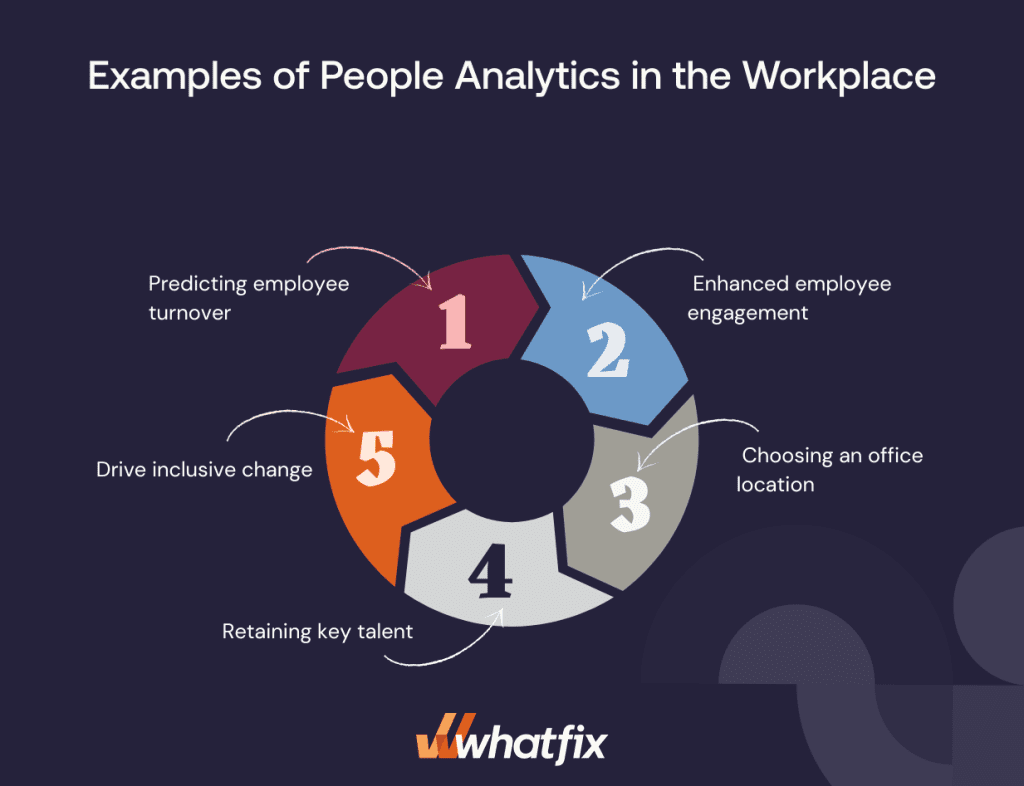
1. Predict employee turnover
People analytics analyzes patterns within employee data to identify early warning signs of disengagement and potential departure. By integrating data from various sources, such as employee surveys, performance evaluations, and attendance records, organizations can apply predictive analytics models to forecast employee turnover risks.
These models assess factors like job satisfaction, team dynamics, workload, and career progression opportunities, enabling HR professionals to pinpoint high-risk individuals or departments. Armed with this insight, organizations can proactively address underlying issues, whether through targeted retention strategies, personalized career development plans, or improvements in workplace culture.
For example, Credit Suisse’s data analytics team evaluates about 10-11 characteristics of individuals and calculates their probability of leaving the company within the next year. The team has studied how factors such as raises, promotions, life events, manager performance, team size impact attrition. A one-point reduction in unwanted attrition rate saves the bank $75 million to $100 million a year.
2. Choose an office location
People analytics analyzes data related to workforce demographics, employee commute times, local labor market conditions, and regional talent pools. By integrating geographic information systems (GIS) with employee address data, organizations can map out optimal locations that minimize commute times and enhance work-life balance for current employees, while also considering the availability of potential future talent in various regions.
This data-driven approach allows companies to evaluate the strategic fit of a location in terms of accessibility, employee satisfaction, and the ability to attract high-quality talent.
For example, with 266 Cisco offices across 87 countries, Cisco’s people analytics team was able to source data about office usage rates and average costs within the organization to determine the best location for a new regional office. Because of the people analytics team and their findings, the company decided to go with a different location than they first had their eye on. Its research found that the original choice would have left the recruitment team struggling to fill the necessary roles.
The findings also changed Cisco’s process for opening new offices by bringing people analytics into the discussion much earlier. Planning, staffing, and operating new offices became much more resource-efficient.
3. Enhance employee engagement
By analyzing data points such as employee feedback, participation in engagement initiatives, performance metrics, and even social interaction patterns, organizations can identify key drivers of engagement and areas of potential disengagement. This approach allows HR leaders and managers to tailor strategies that enhance work experiences, foster a positive organizational culture, and implement programs that boost morale and productivity.
For example, the HR team at Clark, a British shoe manufacturer and retailer, used 450 data points to get an accurate picture of the relationship between employee engagement and overall business performance. The report revealed that for every 1% increase in employee engagement, business performance increased by 0.4%. Additionally, the team also collected additional data from the company’s 100 best-performing stores. This people analytics initiative enabled Clarks to implement multiple changes that improved engagement and increased business performance.
First, they drafted a replicable schema to create high-performing stores, including the ideal team size for optimum efficiency. The company also designed a store management development program and put together an employee engagement toolkit for managers. The CPO reported positive ongoing results after implementing these initiatives.
4. Retain key talent
People analytics provides insights that enable organizations to understand and address the unique needs and drivers of their most valuable employees. Through the detailed analysis of data such as employee engagement scores, performance metrics, career progression paths, and feedback surveys, companies can identify what motivates their top performers and what might lead them to consider leaving.
This information allows for the development of personalized employee retention strategies, such as targeted development opportunities, meaningful recognition programs, and tailored benefits packages that align with the aspirations and life situations of key talent.
For example, Nielsen used people analytics to get multiple insights into their employee behavior. This allowed the analytics team could identify flight risk triggers. People with the highest flight risk in the next six months were approached, and the company was able to move 40% to a new role. Making these lateral moves increased an associate’s chance of staying with the company by 48%.
5. Drive inclusive change
People analytics help uncover and address unconscious biases and foster diversity and inclusion. By meticulously analyzing workforce data—covering aspects such as hiring practices, promotion rates, pay equity, and employee feedback across different demographics—organizations can identify patterns and disparities that may indicate systemic biases or barriers to inclusion.
This objective, data-driven approach enables leaders to pinpoint specific areas for improvement and develop targeted interventions, such as bias training, mentorship programs, and equitable career advancement opportunities.
For example, the University of Warwick used people analytics to reduce the gender pay gap and also address ethnicity and disability representation. They collected data on total pay, bonus pay, staff numbers, and protected characteristics and found out that women were overrepresented in lower-paid roles and underrepresented in higher-paid roles.
The organization was then able to undertake a range of targeted actions to progressively remove the barriers for women to move to senior roles. They piloted leadership and development programs focusing on certain employee groups, such as those who have stayed in the same grade for many years. The organization retained a 100% success rate for female staff applications to professorial positions since 2017 after changing their academic promotions process.
How People Analytics Drive Business Outcomes & Performance
People analytics plays a pivotal role in driving business outcomes and enhancing performance by leveraging data to make informed decisions about workforce management. Here’s how it accomplishes this across five key areas:
1. Identify people needs
People analytics enables organizations to deeply understand the needs, preferences, and challenges of their employees by analyzing patterns and trends in data gathered from various sources, including surveys, performance metrics, and HR systems. This insight helps create a supportive and responsive work environment that addresses individual and organizational needs, leading to higher engagement, satisfaction, and productivity among employees.

2. Reduced turnover
By predicting potential employee turnover by analyzing factors such as engagement levels, job satisfaction, and employee feedback, people analytics allows organizations to proactively address issues that contribute to attrition. Tailored retention strategies, such as career development opportunities, recognition programs, and competitive compensation packages, can be developed to keep high-value employees. Reducing turnover not only saves on the cost and disruption of replacing staff but also retains institutional knowledge and talent.
3. Defining what matters for productivity
People analytics helps identify the drivers of productivity by analyzing work patterns, collaboration networks, and performance data. This enables leaders to understand what factors contribute most to high performance, such as team composition, leadership styles, and work environment characteristics, and replicate these conditions across the organization to boost the overall productivity of the workforce.
4. Higher productivity levels
By analyzing skills gaps, performance data, and career progression paths, people analytics helps create personalized learning and development programs for your employees. These programs are tailored to the individual needs and career aspirations of employees, ensuring that training is relevant and engaging for them. By focusing on developing skills that are directly linked to business objectives and individual growth, organizations can enhance their competitive edge and adaptability.
✓ Thank you, the checklist will be sent to your email
5. Achieving business outcomes powered by people
At its core, people analytics aligns workforce strategies with business outcomes by ensuring that people-related decisions are based on data and insights. By understanding the relationship between workforce dynamics and business performance, organizations can optimize talent acquisition, development, and management practices to directly support business goals. This strategic alignment means that human capital is leveraged effectively to drive growth and competitive advantage, demonstrating the direct impact of effective people management on business success.
8 Steps To the People Analytics Process
Despite the undeniable benefits of people analytics, only 3% of executives agree they have enough data to make informed people decisions. The remaining 97% still struggle to implement a people analytics process because they lack a solid strategy.
The following seven steps will help you start understanding how to create a people analytics strategy for your organization.
Step 1: Define your people analytics goal(s)
If you don’t want people analytics to remain a buzzword for your organization, you need to define the goals once you adopt the process. This way, you’ll be able to gain actionable takeaways and measure the effectiveness of your actions.
Be as specific as possible. What do you want to achieve? Do you want to reduce employee turnover?
Then you need to identify the reasons for high turnover first. It’s also likely that the problem isn’t company-wide but department-specific. In this case, the goal of doing people analytics might be ‘identifying the factors causing turnover in the marketing department.’
We’ve already highlighted the most common use cases for people analytics – you can pick any of the suggested ones or find your own motivation.
Step 2: Identify metrics to track and analyze
Based on the defined objectives, identify specific, measurable metrics that will provide insights into achieving these goals. These could include turnover rates, engagement scores, time to hire, or performance ratings. Selecting the right metrics is crucial for generating actionable insights.
Step 3: Train your HR team
Larger organizations have the resources to hire a dedicated people analytics team. However, having a dedicated department isn’t mandatory for smaller organizations to get started with people analytics.
These organizations can train their HR teams to have the necessary skills for undertaking people analytics effectively. This involves training them in data analysis, understanding of analytics tools, and interpreting data to make informed decisions. A well-trained HR team is essential for leveraging people analytics to its full potential.
Step 4: Communicate the purpose of people analytics
Wonder how would your employees react if you started collecting behavioral data without explaining its reasons? “They ’re measuring our performance… again.”
Frequent performance checks hardly add to your employee morale. That’s why explaining the purpose behind people analytics activities to people outside the HR department is critical. Explain how it will enhance the work environment, improve performance, and support employees’ career development. If you clarify it to your employees, they’ll happily assist you in your people analytics activities.
Step 5: Build your software toolbox
The right tools and technology are vital for an effective people analytics strategy. Implement the software tools and platforms that will support your people analytics processes. This could involve HR information systems (HRIS), HR analytics software, and data visualization tools.
The software enables you to track data around employee performance, attendance, costs, and labor needs to predict future trends and hire accordingly. A comprehensive analytics software helps companies identify inefficiencies, predict productivity, optimize the workforce, and improve return on investment. Further in this guide we’ll list a few people analytics software for you to choose from.
Once you choose your analytics software, implement a digital adoption platform such as Whatfix to help your users adopt the software to its full potential. Remember, buying alone doesn’t guarantee that your HR reps, management, and employees will use the software effectively. This is why complementing your analytics software with a digital adoption platform is a must. Whatever HR analytics software you choose for your business, Whatfix will help you onboard and guide your employees through your new solution via personalized onboarding, in-app guidance and training, and real-time support that’s contextual to the role of each employee.
Software clicks better with Whatfix's digital adoption platform
Enable your employees with in-app guidance, self-help support, process changes alerts, pop-ups for department announcements, and field validations to improve data accuracy.
Step 6: Collect relevant data
Begin collecting the data needed to analyze the identified metrics. This involves gathering data from various sources within the organization, such as HR systems, performance management tools, and employee surveys. Ensuring data quality and integrity during this step is crucial.
Step 7: Evaluate the data
The next step is documenting the data and transforming it into an easy-to-read format. At this stage, you’ll already see certain patterns. For instance, after you’ve collected information on the performance of employees who have recently terminated their contract, you’ll inevitably notice the correlation between poor performance and voluntary turnover.
Mind that you can’t make conclusions based on one single factor. Therefore, you should create a process for analyzing different variables and integrating the data. Only when you have an overview of each variable, develop hypotheses on how these variables correlate.
Step 8: Act on your people data
With the data at hand, start developing and implementing a strategy for addressing the outlined problem.
At this point, your HR department will work together with the management team to discuss the findings and come up with a solution. It can be that you develop different interpretations of the same data. To determine the right solution, you’ll need to check every hypothesis. The process isn’t fast, but eventually, you’ll find a data-driven decision to a problem affecting your business for a long time.
Step 9: Repeat regularly
People analytics isn’t a one-off initiative. Regularly repeat the steps to adjust strategies based on new data and insights, respond to changing organizational needs, and continually refine your approach to workforce management.
If you can involve data analytics experts and developers in the process, do it. In collaboration, they’ll help you to develop a basis for an ongoing employee listening strategy. By automating data collection, you’ll be able to add AI-powered tools to your strategy and build a predictive people analytics model.
5 People Analytics Trends in 2024
Here are five trends that are particularly noteworthy in the evolution of People Analytics.
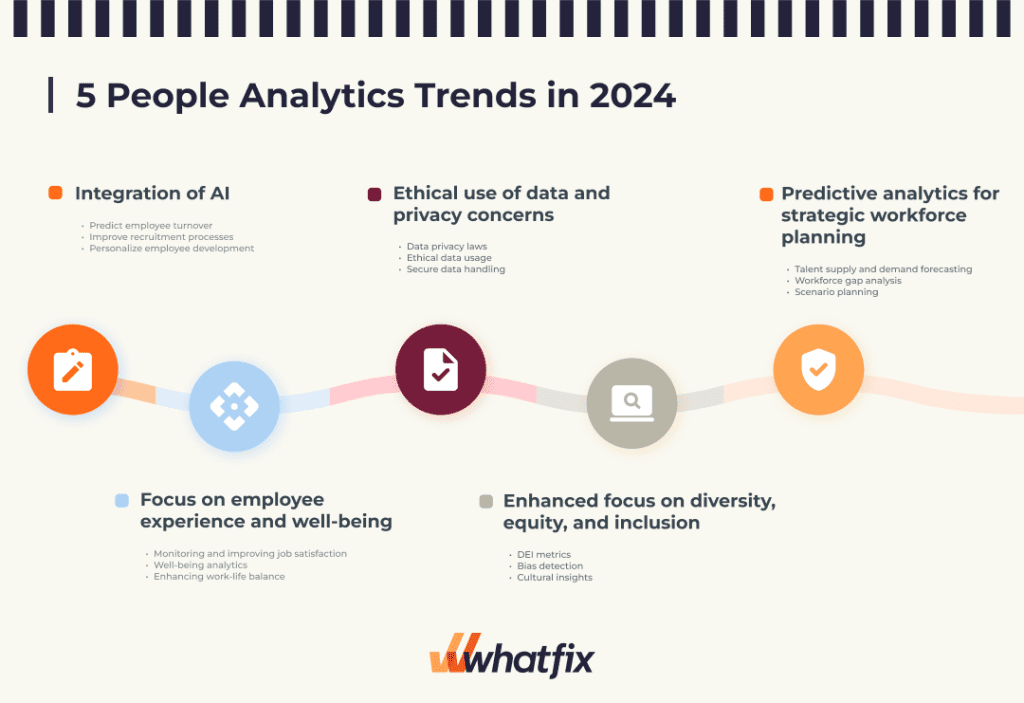
1. Integration of AI
The integration of Artificial Intelligence (AI) into People Analytics represents a significant shift towards more sophisticated, automated analysis of workforce data. AI can process large volumes of data at incredible speeds, identifying patterns and insights that might not be apparent to human analysts. This capability allows organizations to:
- Predict employee turnover: AI algorithms analyze factors such as job satisfaction, engagement levels, and external job market conditions to predict which employees are at risk of leaving.
- Improve recruitment processes: AI enhances the efficiency and effectiveness of recruitment by automating the screening of resumes, predicting the success of candidates, and even identifying the best sources of talent.
- Personalize employee development: By analyzing data on individual performance, learning preferences, and career aspirations, AI helps tailor development programs to cater to the needs of every employee.
2. Focus on employee experience and well-being
Organizations are increasingly recognizing the importance of the employee experience and overall well-being on productivity, engagement, and retention. People Analytics plays a critical role in this area by:
- Monitoring and improving job satisfaction: Surveys, feedback tools, and performance data can be analyzed to identify drivers of satisfaction and areas for improvement.
- Well-being analytics: Data related to work patterns, health, and wellness programs can be analyzed to understand their impact on employee health and stress levels.
- Enhancing work-life balance: By analyzing work hours, workload, and engagement levels, organizations can make informed decisions to promote a better work-life balance.
3. Ethical use of data and privacy concerns
As People Analytics relies heavily on personal and sensitive data, ethical considerations and privacy concerns are paramount. Organizations must navigate:
- Data privacy laws: Compliance with regulations such as GDPR in Europe and CCPA in California, which protect the privacy and data of individuals.
- Ethical data usage: Establishing guidelines and principles for the ethical use of employee data, ensuring it is used in a manner that respects employee privacy and is transparent to those involved.
- Secure data handling: Implementing robust data security measures to protect against unauthorized access and breaches.
4. Enhanced focus on diversity, equity, and inclusion
People Analytics plays a crucial role in promoting and measuring diversity, equity, and inclusion within organizations by:
- DEI metrics: Tracking diversity metrics across different levels and departments to identify areas of improvement and measure the impact of DEI initiatives.
- Bias detection: Using analytics to uncover unconscious biases in hiring, promotions, and performance evaluations.
- Cultural insights: Analyzing employee feedback and engagement data to understand the inclusivity of the organizational culture and identify areas for improvement.
5. Predictive analytics for strategic workforce planning
Predictive analytics uses historical data to forecast future outcomes, helping organizations plan their workforce more strategically. This includes:
- Talent supply and demand forecasting: Predicting future skills requirements and the availability of talent to meet those needs.
- Workforce gap analysis: Identifying potential skill gaps and developing strategies to address them, such as training programs or strategic hiring.
- Scenario planning: Using predictive models to anticipate how changes in the business environment (e.g., market shifts, technological advancements) would impact workforce needs and planning strategies.
Best People Analytics Tools in 2024
You might start with a simple Google Spreadsheet to track your people data, but this is not a scalable solution.
A people analytics tool will allow you to document your processes, store people data for future analysis, and create recurring flows eliminating the need to do a lot of manual work every time you dig into people analytics.
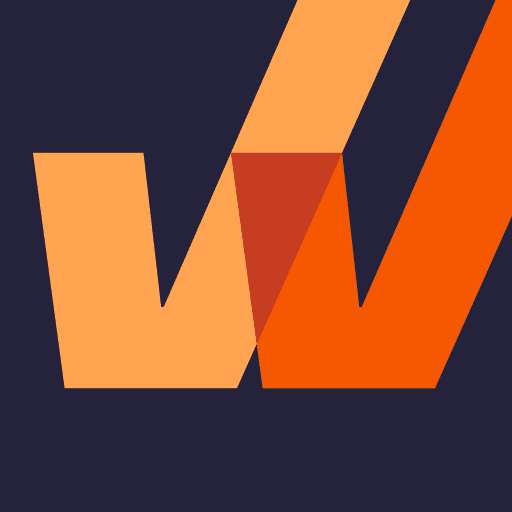
1. Whatfix
G2 Review Rating: 4.6
Price: Talk to the team to get a custom price
Overview: Whatfix is a Digital Adoption Platform that will help you adopt people analytics and make it the heart of your organization.
Buying a people analytics tool doesn’t guarantee your HR reps, management, and employees will be using it effectively. Therefore, complementing your toolkit with a digital adoption platform is a must. Whatever HR tool you choose for your business, Whatfix will help you onboard and guide your employees through a new solution.
Not only the platform allows you to create personalized tips and walkthroughs of your people analytics solution but also delivers insights into the state of technology adoption in your organization.
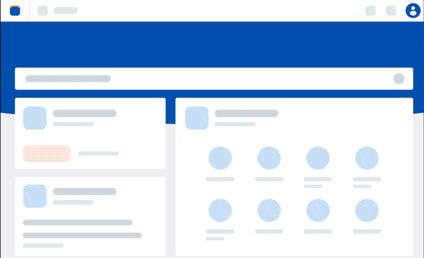
HR and L&D teams can use Whatfix’s analytics features to understand how employees engage with onboarding, training, and support content and use this data to improve existing flows and create new learning content.
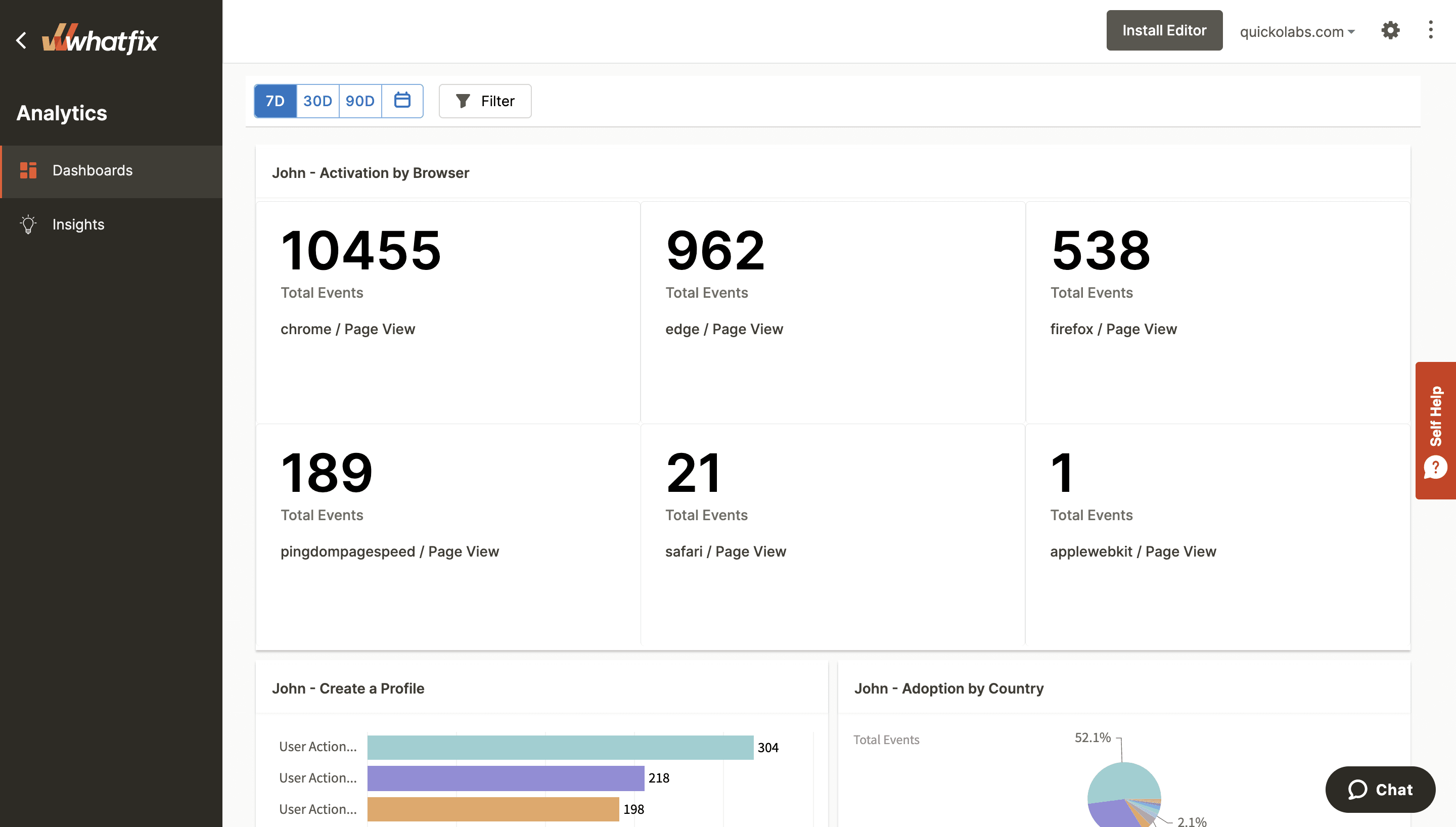
With this workforce data, HR teams can enable their workforce with personalized learning paths that work for different cohorts of employees, helping to drive digital adoption across the organization by building workforce digital dexterity.
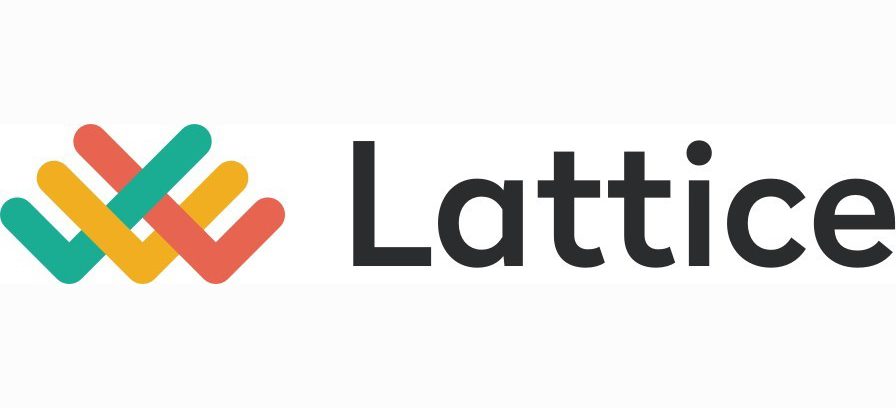
2. Lattice
G2 Review Rating: 4.6
Price: From $8/month per person
Overview: Lattice is a people success platform offering tools for employee listening. Lattice provides solutions for surveying employees, running 1:1’s, measuring organizational health, and more.
It’s great for collecting real-time analytics and can become a solid basis for building an automated people analytics process.

3. BambooHR
G2 Review Rating: 4.4
Price: From $4.95/month per person
Overview: BambooHR is an all-in-one HR platform. It facilitates the processes of gathering, storing, and analyzing people data. The platform allows HR reps and people managers to create secure employee databases either by using templated workflows or by creating custom fields.
Here you’ll find detailed HR reports, charts, records on individual employees, and other critical data for making people decisions.
BambooHR’s features aren’t limited to people data and analytics. It also offers helpful tools for hiring, onboarding, employee management, and offboarding.

4. intelliHR
G2 Review Rating: 4.8
Price: From $3.25/month per person
Overview: intelliHR, people management software, is a perfect place for centralizing all HR data.
The platform focuses on employee engagement and wellbeing. Employee Net Promoter Score (eNPS) surveys, wellbeing pulses, sentiment analysis, exit interviews, etc. – all of these can run with the help of intelliHR.
You’ll like intelliHR if you’re looking to understand the reasons behind employee turnover, increase retention, and boost employee engagement.

5. Visier People
G2 Review Rating: 4.4
Price: Talk to the team to get a custom price
Visier People is a dedicated people analytics platform. It offers tools for collecting core HR metrics, running predictive analysis, and comparing your data to industry benchmarks.
With Visier People, it’s easy to capture organizational change and keep track of the evolution of your workforce. The platform lets you easily create custom charts and compare statistical data month after month, year after year.
As organizations implement People Analytics software to foster a more engaged and productive workforce, the importance of providing employees with real-time, contextual guidance on the tool cannot be overstated. Whatfix provides a personalized onboarding & training experience on your analytics software with customized pop-ups, smart tips, and interactive walkthroughs – ensuring faster learning and an accelerated onboarding experience.
By empowering your workforce with Whatfix, you not only enhance the employee experience but also maximize the impact of your People Analytics initiatives, driving your organization towards greater success and innovation.
To learn more about Whatfix, click here to schedule a free demo with us today!
Request a demo to see how Whatfix empowers organizations to improve end-user adoption and provide on-demand customer support
Thank you for subscribing!
